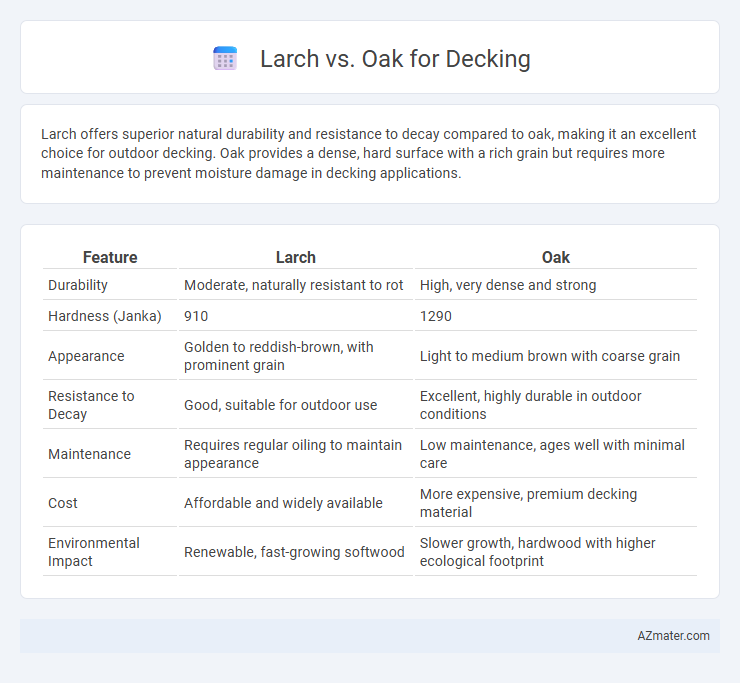Larch offers superior natural durability and resistance to decay compared to oak, making it an excellent choice for outdoor decking. Oak provides a dense, hard surface with a rich grain but requires more maintenance to prevent moisture damage in decking applications.
Table of Comparison
| Feature | Larch | Oak |
|---|---|---|
| Durability | Moderate, naturally resistant to rot | High, very dense and strong |
| Hardness (Janka) | 910 | 1290 |
| Appearance | Golden to reddish-brown, with prominent grain | Light to medium brown with coarse grain |
| Resistance to Decay | Good, suitable for outdoor use | Excellent, highly durable in outdoor conditions |
| Maintenance | Requires regular oiling to maintain appearance | Low maintenance, ages well with minimal care |
| Cost | Affordable and widely available | More expensive, premium decking material |
| Environmental Impact | Renewable, fast-growing softwood | Slower growth, hardwood with higher ecological footprint |
Introduction to Larch and Oak Decking
Larch decking offers exceptional durability and natural resistance to rot, making it ideal for outdoor use with a warm, reddish hue that enhances aesthetic appeal. Oak decking provides superior hardness and strength, known for its robust grain pattern and longevity, suitable for heavy traffic areas. Both wood types are sustainable choices, with larch being more affordable and oak delivering premium performance and classic sophistication.
Appearance and Aesthetic Differences
Larch decking showcases a warm, reddish-brown hue with distinctive fine grain patterns that develop a natural patina over time, contrasting the classic, deep brown to golden tones of oak with its tight, prominent grain and occasional knots. Oak often appears more uniform and polished, offering a traditional, elegant aesthetic ideal for formal designs, while larch provides a rustic, textured look suited for natural, outdoorsy settings. The contrasting color stability and grain clarity between larch and oak significantly influence the overall visual appeal and style of decking projects.
Durability and Longevity Comparison
Larch offers moderate durability with natural resistance to rot and insects, making it a cost-effective choice for decking that typically lasts 15-25 years when properly maintained. Oak, particularly white oak, exhibits superior durability due to its dense grain and high tannin content, often extending decking lifespan beyond 30 years with adequate care. The natural resilience of oak results in better weather resistance and less frequent maintenance compared to larch, positioning it as a premium option for long-lasting decking projects.
Resistance to Weather and Decay
Larch wood offers excellent resistance to weather and decay due to its natural high resin content, making it a durable choice for outdoor decking in humid and wet climates. Oak, particularly white oak, also provides strong resistance to moisture and decay because of its dense grain structure and tannins, but it typically requires more maintenance to prevent surface weathering over time. Both woods perform well against rot and pests, though larch tends to be more cost-effective and sustainable for decking exposed to harsh environmental conditions.
Maintenance Requirements
Larch decking requires less frequent sealing and is naturally resistant to rot and insects, reducing overall maintenance efforts compared to oak. Oak decking demands regular sealing and treatment to prevent moisture damage and fungal growth, increasing upkeep requirements. Choosing larch can significantly lower long-term maintenance costs due to its durability and natural resilience in outdoor conditions.
Environmental Impact and Sustainability
Larch wood is a fast-growing softwood with a lower carbon footprint compared to the slow-growing, dense oak, making it more environmentally sustainable for decking. Oak's durability and natural resistance to decay reduce the need for chemical treatments, but its slower growth rate and longer rotation period result in higher ecological impact. Choosing larch supports responsible forest management and promotes renewable resources, while oak provides longevity that can offset initial environmental costs through prolonged use.
Cost Comparison: Larch vs Oak
Larch decking is generally more cost-effective than oak, with prices typically 30-50% lower due to its faster growth and wider availability. Oak, known for its durability and premium appearance, commands a higher price that reflects its density, strength, and resistance to wear. Budget-conscious projects often favor larch for balancing quality and affordability, while oak suits high-end decking requiring exceptional longevity and aesthetic appeal.
Installation and Workability
Larch offers easier installation due to its lighter weight and natural straight grain, allowing for smoother cutting and fastening compared to oak. Oak's hardness and density increase durability but require pre-drilling and sharper tools to prevent splitting, which can prolong the installation process. Both woods provide excellent workability, but larch is favored for quicker, less labor-intensive decking projects.
Best Uses and Ideal Applications
Larch offers strong resistance to moisture and decay, making it ideal for outdoor decking in humid or coastal environments. Oak provides superior hardness and durability, suitable for high-traffic decks or areas requiring long-lasting structural support. Both woods excel in different climates: larch is best for wet conditions, while oak is preferred for heavy use and aesthetic appeal.
Final Verdict: Which Wood is Better for Decking?
Larch offers exceptional durability and natural resistance to rot, making it a cost-effective choice for decking in wetter climates, while oak provides superior hardness and strength, ideal for high-traffic areas requiring longevity. Oak's tighter grain structure ensures better structural stability and a more refined aesthetic over time, though it demands regular maintenance to preserve its appearance. Choosing between larch and oak depends on balancing budget, maintenance willingness, and desired durability, with oak being preferable for premium, long-lasting decks and larch excelling in budget-conscious, weather-resistant applications.

Infographic: Larch vs Oak for Decking
 azmater.com
azmater.com